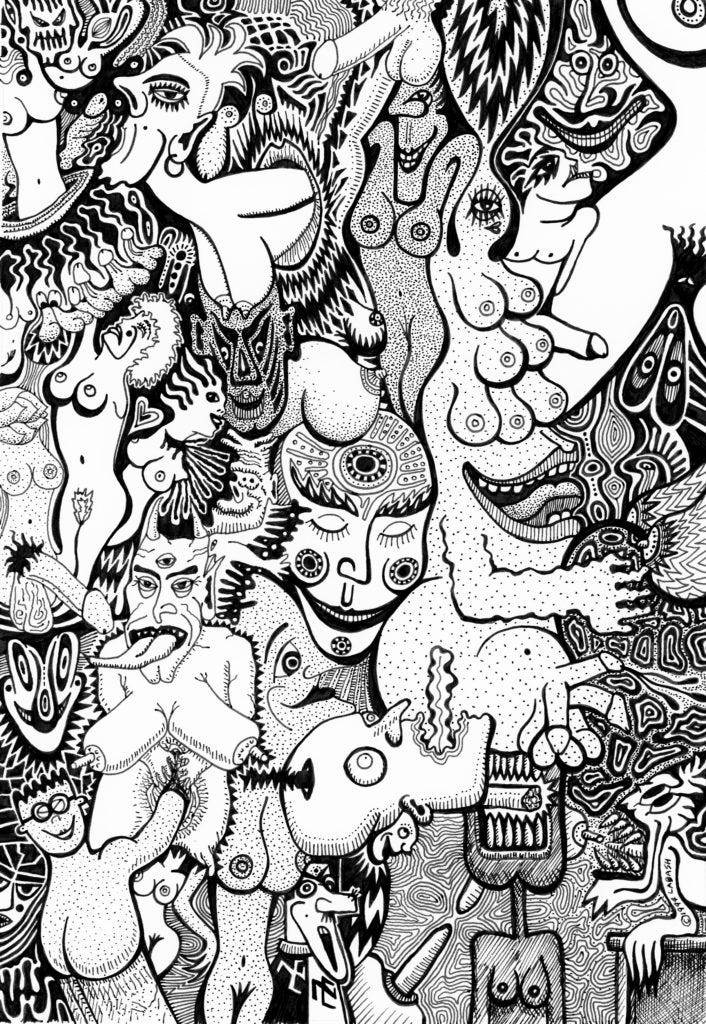Excerpt from “The Combine Plot”
Originally written in 1990, The Combine Plot was widely published in such publications as P-Form Magazine and Short Fuse.
For months I have been thinking about writing a piece about what I call the plot of fragmentation. It would be about the aspect of the plot that focuses on making us think that to do anything meaningful, to be an effective force for change, you have to reach a large number of people, commonly known as THE MASSES or THE MASS MARKET. I was going to talk about how this aspect of the plot has limited art by making artists and galleries think that to reach this market, or at least a fraction of it, artists have to reach levels of educational, technical, and marketing skills which are set by, and acceptable to, the real world of mass communications.
Moreover, the subject matter was set to certain “in fashion” areas such as AIDS, feminism, the homeless, the environment, etc…what are “in fashion” subjects keep changing every six months or a year (obviously, the homeless people did not get homes nor did people stop dying of AIDS…rather, the glamour attention-span wears off and the focus quickly switches before things crack through the surface into the uncomfortable depth of universals where issues explode, leaving us trying to live together).
This aspect of the plot leads artists on a chase of college degrees, of skills to operate high-tech art-making machines, of money or positions that will give them the opportunity to do art, even when the style, the subject matter, and maybe the content of the art is dictated by this chase, by the combine plot.
This was what I was planning to write about. I was going to call it THE PLOT OF BIGNESS. But the plot has overtaken me during my thinking about the article. I see in the press that Sen. Jesse Helms and Rep. Dana Rohrabacher have nominated me, along with Annie Sprinkle, Karen Finley, Johanna Went, Cheri Gaulke, as well as other unnamed artists, to be the next target in their war on art. By doing so, Dana and Jesse have given us artists a platform from which to fight the plot. Because doing battle with the combine plot is one of the main functions of an artist, I am flattered to be nominated as one of the top ten on the new McCarthy hit list. I was feeling left out. All my heroes in the past were banned, jailed, harassed for their work. Artists such as Finley who I respect have been fighting the censors for years. My ego was crushed when I saw Rohrabacher on CNN label Annie Sprinkle a threat to the established moral order. After all, my work is as threatening as hers. But days later, someone sent me the NEW YORK CITY TRIBUNE (Feb. 5) special report that named names, and my name was there. What a relief! I only wish Dana and Jesse had invited me to testify. Jesse, I am available.
I know the last paragraph sounds like light humor…not taking the war seriously. It is a serious war with the high stakes of freedom and liberty for everyone. But you must understand the nature of the combine plot. It does not understand humor or the personal level. It can crush you if you operate by the mass rules and try to fight it on its terms. But once you drop out of the mass headset, the plot becomes very fragile, very threatened. This is why the plot’s Helms is after me and you. Because of this, my article is forced to take on a larger scope and a certain nonlinear quality. Please bear with it.
To understand what is really going on under this “sex” witch-hunt, it is important to understand the nature of the general plot of fragmentation, the combine plot. I took the word “combine” from the novel One Flew Over the Cuckoo’s Nest by Ken Kesey. In the book, the combine is a fear machine network which secretly installed pacemakers of fear, doubt, and mistrust in almost everyone in childhood. This made people much easier to control. It isolates people into cells padded with fear and doubt, making the people part of the combine. There are some misfits whom the combine missed with its fear pacemakers. In others, the fear pacemakers blow their fuses. These people without the fear pacemakers are very dangerous to the combine because if they are not checked, destroyed, discredited, isolated, or enfolded into the combine, they can show others how to blow out their own fear pacemakers, can show others how to be free humans linked to other free humans. The combine rarely has to directly destroy the misfits itself. Just direct eliminations would reveal the existence of the combine. So such direct eliminations are kept to the minimum. The real tool of the combine is a vague sense of uncomfortableness, of inferiority, and of mistrust within the victims of the combine. The setting of the novel is a mental ward in which most of the patients are self‑committed. They believe themselves weak, unable to cope with the outside world. They believe the fear comes from themselves, not from the pacemakers. They just have to start believing in themselves, and they could pull out the pacemakers and walk out of the hospital. But every time they reach this threshold of freedom, the combine, by clever remote manipulation, turns up the vague uncomfortableness and mistrust. The victims themselves do the destroying of the misfit either in themselves or that con man pied piper who laughs at their fears and limits, who shows them the way to freedom. It is the victims who do most of the censoring.
Read the full essay here: https://www.eroplay.com/Cave/Writings/combineplot-web.pdf
Also published in Frankly Speaking: Essays, Writings & Rants by Frank Moore.



